Prevention
is the emphasis of our office
Oral Health Articles
|
Other
Oral Health
Topics |
|
In our
practice our goal
is to show you where to find the best answers for your dental questions. Find
your topic of interest in our articles above, or use the links
we have researched and organized for you. These are the best sources for oral health topics on
the internet.
Learn about brushing techniques,
flossing, tooth decay, dentistry for children, prevention of cavities, gum
diseases, root canal treatments and hundreds of other topics in oral health
and dentistry.
|
How to
Brush Your Teeth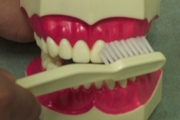
The next
issue is to choose a good toothpaste. In general any toothpaste that
contains Fluoride will do the job, unless you have a special need that is
determined by your dentist. Two of the best brands of toothpastes are
Colgate Total and Crest Multicare.
The first
rule of brushing is to start from a specific location and work your way to
the opposite side and all the way through the whole mouth so that you end
where you started. This way you won’t
miss any area. Also usually a pea size of tooth paste is
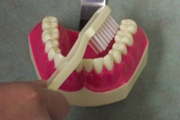 enough. A good brushing should at lease take 2
minutes and ideally around 4 minutes. enough. A good brushing should at lease take 2
minutes and ideally around 4 minutes.
There are
many different techniques for brushing your teeth but one of the most
popular ones is described here:
Hold the
brush with a 45 degree angle toward the teeth and the gum. Gently press
against the gum so the tips of the bristles go in between the gum and the
teeth. Then apply lateral vibration for a few times and roll down the brush to
sweep the plaque away from the teeth and the gum. Repeat this motion 6 to 10
times and move on to the next area of 2 to 3 teeth. If your mouth is full of
foam, spit out and continue brushing. Your brushing is completed when you
have brushed all the surfaces of your teeth and not when your mouth is full! to
sweep the plaque away from the teeth and the gum. Repeat this motion 6 to 10
times and move on to the next area of 2 to 3 teeth. If your mouth is full of
foam, spit out and continue brushing. Your brushing is completed when you
have brushed all the surfaces of your teeth and not when your mouth is full!
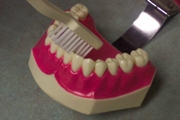 On chewing
surfaces, short strokes will work best to get the plaque out of the grooves
and pits. Also when brushing the front teeth from inside, hold your brush
vertically to be able to reach the teeth better. On chewing
surfaces, short strokes will work best to get the plaque out of the grooves
and pits. Also when brushing the front teeth from inside, hold your brush
vertically to be able to reach the teeth better.
As far as frequency of brushing is concerned, ideally you want to
brush your teeth after each meal. But if you can't, brush at least twice a
day after breakfast and before going to bed.
Back to Top
|
How to Floss Your Teeth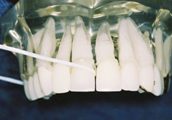
To start, cut a
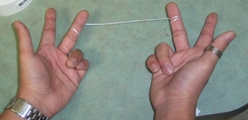 piece of dental floss (approximately 2 feet). Wrap
both sides of the floss around your middle fingers. Using your index and
thumb move the floss in between all your teeth one by one. When flossing,
make sure you are not cutting your gum. The goal is to clean the teeth
surfaces and not the gum. In each space in between the teeth, press the
floss against each tooth (hug the tooth) and gently move it back and forth
and up and down and then move to the opposite surface of the adjacent tooth. piece of dental floss (approximately 2 feet). Wrap
both sides of the floss around your middle fingers. Using your index and
thumb move the floss in between all your teeth one by one. When flossing,
make sure you are not cutting your gum. The goal is to clean the teeth
surfaces and not the gum. In each space in between the teeth, press the
floss against each tooth (hug the tooth) and gently move it back and forth
and up and down and then move to the opposite surface of the adjacent tooth.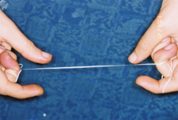
Back to Top
|
Bad Breath
1- Tongue
(when bacteria grows in between the papilla) 2- Teeth cavities (especially
when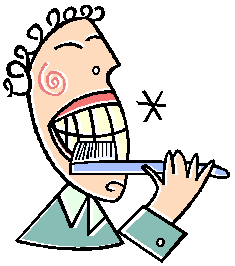 food particles get stuck in them) 3- Gum diseases 4- Extraction sites
during healing 5- Dentures when not cleaned properly 6-Alcohol and tobacco food particles get stuck in them) 3- Gum diseases 4- Extraction sites
during healing 5- Dentures when not cleaned properly 6-Alcohol and tobacco
If you or
someone you know is concerned about bad breath, the first step is a dental
check up. Your dentist will be able to confirm or rule out teeth or mouth as
the source of bad breath.
When the
reason is found, treatment will be explained by your dentist. If the
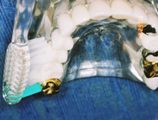 source
of the bad breath is your mouth there is little chance that mouth washes or
mints can treat the problem. They usually mask the problem for a short
period of time. They can even sometimes make the situation worse (mouthwashes that contain alcohol cause dry mouth and that usually makes the
bad breath worse). source
of the bad breath is your mouth there is little chance that mouth washes or
mints can treat the problem. They usually mask the problem for a short
period of time. They can even sometimes make the situation worse (mouthwashes that contain alcohol cause dry mouth and that usually makes the
bad breath worse).
These are a
few other, non-dental reasons that cause bad breath: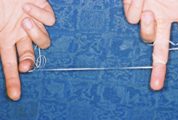
1- Sore
throat 2- Tonsillitis 3- Some foods 4- Infection of air passages.
Following a
good oral hygiene routine and getting regular check ups with your dentist
are best ways of preventing bad breath.
Back to Top
|
Electric Brush Versus Manual
Brush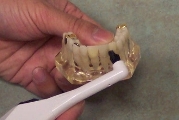
Although not all the electric brushes are the same, in conclusion of
all these studies it is fair to say that in general electric brushes are
more effective in controlling the plaque than manual brushes. Theoretically
you could do a very good brushing with a regular hand brush but the
movements of an electric brush makes the task easier and more efficient.
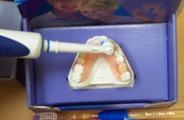 Also,
some electric brushes (Sonicare) have sonic vibration that is difficult to
mimic with a hand brush! Other electric brushes like Oral-B and Rotadent have
small heads that help you reach hard to reach areas of your mouth. This
aspect is more important when you are talking about somebody with
orthodontic braces or a history of gum disease. Also,
some electric brushes (Sonicare) have sonic vibration that is difficult to
mimic with a hand brush! Other electric brushes like Oral-B and Rotadent have
small heads that help you reach hard to reach areas of your mouth. This
aspect is more important when you are talking about somebody with
orthodontic braces or a history of gum disease.
Back to Top
|
Dental
Health and Your Diet
Probably the
worst thing you can do to your teeth is to hold a soda and have a sip every
few minutes during a long period of time; the same is true for snacking. It is
recommended that if you want to have a snack or a soda or juice it is better
to have it after food, as dessert or have it in one sitting. Eating or
drinking something sweet during a long period of time creates a
constant supply of sugar for bacteria that cause tooth decay!
It is
important to know all the sources of sugar. It is not just everything that
is sweet but anything that can turn to sugar like pieces of bread. Cutting
down your sugar intake is good for cavity prevention as well as general
health.
When you
have to have sugar! The best way to prevent cavities is to prevent the sugar
from staying next to your teeth. Brushing after eating sugar, rinsing your
mouth with Fluoride mouth wash or chewing sugarless gum can help. But
nothing has the effect of avoiding sugar!
Is there
any kind of food that prevents tooth decay? Well, not really. Some people
believed that chewing foods like apple and carrots may have some plaque
removal effect, but they still contain some sugar so any advantage of them
is not clear.
Another
group of food that causes significant damage to teeth structure is acidic
foods. Things like lime, lemon and grapefruit, if in frequent contact with
teeth, can cause serious irreversible damage (erosion) to your teeth.
Back to Top
|
Fluoride and
Decay Prevention
Fluoride that is absorbed by your body when teeth were forming (during
mother's
pregnancy to early childhood) integrates into the structure of enamel and
makes it stronger.
After
teeth eruption fluoride that is inside your toothpaste or mouthwash, or what
your dentist places on your teeth still have a positive effect on your
teeth. It strengthens the enamel and reduces the chance of tooth decay.
If you have children and live in an area that has no Fluoride in
its drinking water you should consult your dentist and physician
about Fluoride tablets that are available for children.
Back to Top
|
|